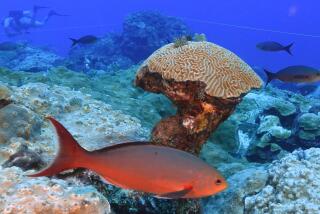Florida Keys Threatened by Tourism : Visitors and growth imperil water quality, mangrove swamps and coral reefs.
- Share via
ISLAMADORA, Fla. — President Bush’s selection of this idyllic island of coral reefs, palm trees and championship fishing for a recent vacation gave another boost to local tourism, but it was a mixed blessing for the Florida Keys.
Although Islamadora and its neighbors in the keys depend almost wholly on tourism, the smashing success of the tourist industry in the last decade is threatening to shatter the delicate semitropical ecosystems that attract visitors here in the first place.
In fact, environmentalists say, the keys have become a model for a growing nationwide problem: the pressures that threaten the environmental quality of parks and nature preserves situated in or near densely populated urban areas.
BACKGROUND: The last two decades have seen a staggering increase in the number of visitors to the nation’s parks, wildlife refuges and once-remote wilderness areas. From Yosemite to the Great Smokies, regions of great natural beauty must struggle to avoid being loved to death.
The threat to areas such as the Florida Keys may be among the most difficult to deal with. Yellowstone, for instance, gets at least a degree of respite during its long, cold winter.
By contrast, not only do more than a million tourists a year now pour into the keys--the chain of islands stretching from the tip of Florida south into the warm waters of the Gulf of Mexico--but more and more people are seeking permanent or semi-permanent residence here.
In the late 1970s, the state and federal governments cooperated to build new bridges and a wider roadway to the keys that made the trip south possible for thousands of additional visitors each day. That, in turn, sparked a tourist boom in the 1980s. Land values soared. Dozens of new hotels sprang up, as did scores of new businesses offering diving instruction, fishing tours, jet skis and boat rides.
But the 1990s are bringing second thoughts about growth. In recent elections, residents picked two county commissioners who ran with support of environmentalists.
And, last fall, Congress voted to turn the entire coastal shelf around the keys into a massive marine sanctuary. At 2,600 square miles, it is the largest such sanctuary in the nation--and the second-largest in the world (after Australia’s Great Barrier Reef).
ISSUES: The problems facing the new sanctuary are daunting. Foremost are waste disposal and water quality.
“The coral reefs in Florida are at the northern geographic limit” for coral, said Paige Gill, education coordinator for the small Key Largo National Marine Sanctuary. “Because they’re at the edge, it doesn’t take much to push them over the edge.”
And many reefs may now be teetering.
The most dramatic danger comes from collisions by inept boaters. But a more serious, and far more intractable, problem may be posed by a quiet explosion in the growth of algae.
Marine officials in recent years report worrying increases in algae choking reefs close to shore and in black-band disease, an infection of coral reefs by a single-celled blue-green algae, which has damaged some reefs farther out.
In both cases, scientists trace the problem to an increase in the amount of nutrients in the waters.
Part of the problem may be caused by runoff of agricultural fertilizers from the South Florida mainland, but the prime suspect is septic tanks, which release nitrogen, phosphorous and other algae-supporting nutrients into the water table.
Onshore, the most serious problem is the increase in development, which threatens to wipe out coastal mangrove swamps that are the nursery grounds for fish. The spread of civilization is also overrunning the habitat of species such as the small, endangered key deer.
OUTLOOK: Federal officials have three years to develop a management plan for the new marine preserve. Meanwhile, the state and federal governments have 18 months to try to develop a new water quality plan.
Onshore, environmentalists are waging a concerted effort to attract private and public funds to buy vital acreage before the land can be developed.
But federal budget cuts have created a billion-dollar gap between aspirations and resources for the Land and Water Conservation Fund, Washington’s buying agent for federal parks and wildlife refuges. The added attention Bush brought the keys may only intensify the problem.
More to Read
Sign up for The Wild
We’ll help you find the best places to hike, bike and run, as well as the perfect silent spots for meditation and yoga.
You may occasionally receive promotional content from the Los Angeles Times.







